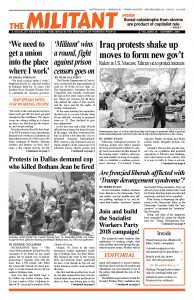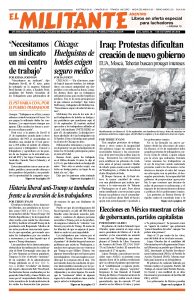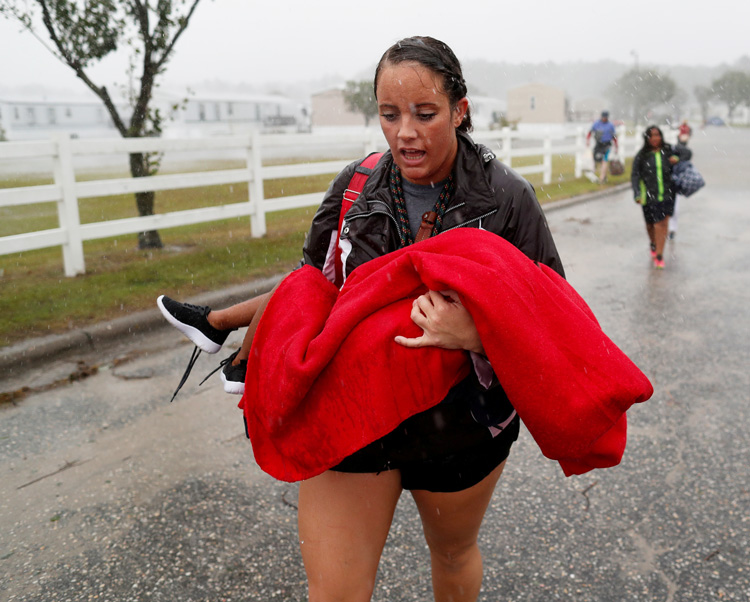According to the liberal news media, nature’s inevitable storms and floods, exacerbated by rampant global warming, are the reason for the unfolding social disasters in North Carolina, the Philippines and Puerto Rico in the wake of Hurricane Florence, Typhoon Mangkhut and Hurricane Maria.
The Washington Post went so far as to blame President Donald Trump because of his stance on climate change. “Another hurricane is about to batter our coast. Trump is complicit,” the Post editorialized Sept. 11 before Florence struck.
And when they’re not blaming global warming or Trump, the capitalist press blames working people for choosing to live in harm’s way.
But all this takes the fire off the real cause of the deaths and destruction — the profit drive and dog-eat-dog morality of capitalism.
The biggest damage from Florence came not from wind, but from flooding. But the dangers of flooding on the North Carolina coast and rivers is nothing new. Nonetheless North Carolina legislators in 2014 scrapped a code requiring new construction in flood zones to rise a foot or more above the Federal Emergency Management Agency base flood level.
Contractors, real estate interests, land speculators and banks, backed by governments at every level, promote profit-generating construction in low-lying areas and flood zones.
The higher risk of flooding makes the land cheaper, pushing workers to live in those riskiest areas. In Lumberton, North Carolina, those who live in the low-lying areas around the Lumber River are among the poorest in Robeson County. When Hurricane Matthew hit in 2016, the river crested more than 24 feet. The city flooded again this time.
As of Sept. 18 there were no official statistics on how many homes were damaged by the hurricane or how many people left homeless. But in New Bern, North Carolina, alone more than 4,300 homes were damaged or destroyed.
Many workers will be hit with a double whammy. “Florence Is a Tragedy for Homeowners, Not Insurers,” says the headline of the Sept. 17 Wall Street Journal, noting that wind damage is covered by most insurance policies — for those working people who can afford them — but not flood damage.
Landlords profit from storms
The next day the Journal noted that the storm will be a boon for big landlords. The paper said after Hurricane Harvey hit Texas last year, landlords took advantage of the increased demand for housing by jacking up rents. With thousands made homeless by Florence, North Carolina landlords with buildings still standing seek to make a killing.
As Florence approached, state and local governments in the Carolinas and Virginia ordered some 1.5 million people to evacuate. But working people were left on their own to comply. No nearby relatives in a safe area? Not enough money for a hotel or gas? No car? At best you might get loaded on a bus and taken to an overcrowded shelter.
Few warnings about Florence were issued in Spanish and many of North Carolina’s 150,000 farmworkers were unaware of the scope of the coming storm.
Capitalism creates the same types of challenges worldwide. Philippine officials claim they had learned from their mistakes during 2013’s Typhoon Haiyan, which devastated a large part of the country, leaving 6,000 dead and destroying 1.2 million homes. The government did little to organize an evacuation or position relief supplies in advance.
This year officials evacuated more than 105,000 people to temporary shelters before the arrival of 550-mile-wide Super Typhoon Mangkhut. The storm cut a swath through less densely populated areas, mainly on Luzon Island, the food breadbasket of the Philippines, but still put millions at risk.
Like in the U.S., it’s working people and the poor who are forced to live in the areas most vulnerable to flooding and landslides. Most of the dozens who died in this year’s storm were buried in landslides in mountainous regions due to the heavy rainfall.
Many small farmers ignored calls to evacuate, worried they would lose what little they have in a region where many get by on $2 or less a day. They saw staying put as the lesser evil. “Our house was blown away. We were flooded,” Diday Llorente told Agence France-Presse. “We did not evacuate because we didn’t want to leave our carabao (water buffalo) and livestock.”
At least 32 people died in a mining town in Benguet province when they took shelter in a church that was buried in a landslide. Dozens of miners joined rescue teams, trying to find survivors and dig out bodies by hand.
That’s another side of the social disaster that working people share around the globe. They find they can’t rely on the government, but have to take care of each other in the face of the disaster.
In North Carolina, like in Texas last year, working people, including volunteers from the self-organized Cajun Navy, used their own boats to rescue people trapped in their homes or cars.
In Wilmington, North Carolina, with all roads to the city impassable and food running short, a group of workers pooled whatever they had. Deborah Phillips told the Journal that her neighbors scraped together a few vegetables, a tomato and a hambone. They called it “Hurricane Florence soup,” she said. “It was pretty good.”
Only in Cuba are things done differently.
Led by their government, working people in revolutionary Cuba are organized to put human lives first when a dangerous storm approaches. Everyone in a danger zone, and their pets, are evacuated. Volunteers help harvest crops before the storm hits and move livestock to safety. Shelters are stocked with food and water and staffed with doctors and nurses. From getting ready before the storm arrives, to weathering it, to rebuilding afterwards, no one is left on their own.
This is possible because working people in Cuba made a revolution in 1959 and took power out of the hands of the capitalist class. Workers and farmers from the U.S. to Puerto Rico to the Philippines need to do the same.


